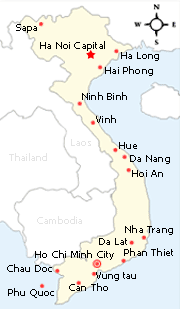|
Underground spring answers call of thirst in Binh Dinh’s ‘yelling cellar’ "Would you like to go and hear the cellar yelling?" a friend asked me when I was in Quy Nhon city in the central province of Binh Dinh.
Tranquil setting: Stilt houses built under the shade of big trees allow visitors to enjoy the beauty of the area in comfort. Hiring a motorbike, we drove for an hour to Ham Ho, 45km from the city and one of the province’s most attractive eco-parks. The spring is downstream of the Kut river and adjoins Phu Yen and Gia Lai provinces. There is a fascinating legend about the place. A long time ago, the region suffered serious droughts every year. Once local residents had almost nothing to eat or drink and their imploring screams filled the entire region. The Jade Emperor was moved and dispatched the God of Rain to create streams and rivers, saving lives. The Kut river and Ham Ho stream were believed to be created at that time and links the imposing Central Highlands with the East Sea. The spring runs a few kilometers through a shallow, bumpy ravine with high, rocky walls on either side. It spills into a lake that resembles a large rocky cellar. When the water flows into that cellar, it produces a noise remarkably like a yell. Hence its name. Another explanation for the origin of the name is equally curious: at the peak of summer, when locals expect rain, they often hear noises like people screaming in the night. Soon, it begins to rain. But this has a more mundane explanation. Ham Ho is in the downstream part of Kut River where the water runs between two mountains. Here, the temperature here is often lower in comparison with the valley. So, when rain clouds gather and blow through the thick foliage and caves near Ham Ho, the air appears to scream. Nature’s bounty
Nature’s sculpture: A rock that looks like a partly submerged elephant in the Kut river. They were mandarins sent by the Latter Le dynasty in the 17th century to build a dyke to harness the Ham Ho’s waters. Older brother Boi died before the work was completed, a victim of the harsh terrain. Bang finished the dyke. A temple was built in their honour and a memorial ceremony and festival is held here on the 20th of the first lunar month. Leaving the temple, we moved to a pier. A small canoe took us 500m along a narrow canal to the dyke on Ham Ho. The stream was an impressive sight with hundreds of granite stones jutting out in the middle, much like a miniature Ha Long Bay. Stopping at the "Lying Buffaloes" puddle, we seemed to step into a floating stone forest with limpid water. On the bank, leaves and flowers in a dazzling array of colours and the sounds of birds made the scene fetching. Further upstream, more rocks constricted the flow of water. We walked until we reached a steep stone wall covered in green moss and a bunch of ancient tree roots. In the stream, we fancied we saw rocks that looked like a large crocodile, hon banh it (a kind of cake), da mai nha (roof), da ban co (chessboard), dau chan khong lo (giant footprint), even a group of fairies combing the water. The wild beauty evokes in beholders images of a world inhabited by gods. Thus, Ham Ho also has other names like "Gate to Heaven". On the banks of the spring are stilt houses built under the shade of large trees for visitors to relax, enjoying the fresh air and stunning sights. It is tailor-made for trekking, and the place also offers kayaking in the spring and swimming in front of the Hoa Loc Vung restaurant. The restaurant is named after the ornamental tree, lecythidales, which is very common in the area. It serves popular culinary specialties like fried stream fish and roasted birds caught in sugarcane fields. Ham Ho is also known as "flying fish spring" because of the thousands of fish swimming back upstream to their birthplace to spawn. Inaccessible Ham Ho served as a military base during the Tay Son uprising in the 18th century. General Vo Van Dung’s troops carried out their drills here. It was also the site of Mai Xuan Thuong’s battle against French colonialists in the early 20th century. Nowadays, 150,000sq.km of the area are protected by the law and receives around 70,000 visitors each year. "If you want to fully experience Ham Ho, you should spend a night here. Staying in a stilt house and enjoying the peace of the night, you could hear the strange noises that give Ham Ho its name," Nguyen Dinh Sanh, director of Ham Ho tourism company, tempted us. Though we would have loved to stay, time was limited and we had to leave. But we promised ourselves we would return soon. VietNamNet/Viet Nam News Other news for Tuesday 18 August, 2009
View all news for Tuesday 18 August, 2009 on one page News for Monday 17 August, 2009 View all news for Monday 17 August, 2009 on one page Recent News
|











